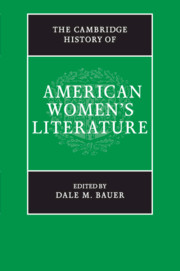Book contents
- Frontmatter
- Contents
- List of illustrations
- Acknowledgements
- Notes on contributors
- Introduction
- 1 The stories we tell: American Indian women's writing and the persistence of tradition
- 2 Women writers and war
- 3 American women's writing in the colonial period
- 4 Religion, sensibility, and sympathy
- 5 Women's writing of the Revolutionary era
- 6 Women writers and the early US novel
- 7 Women in literary culture during the long nineteenth century
- 8 Moral authority as literary property in mid-nineteenth-century print culture
- 9 The shape of Catharine Sedgwick's career
- 10 Writing, authorship, and genius: literary women and modes of literary production
- 11 Nineteenth-century American women's poetry: past and prospects
- 12 Transatlantic sympathies and nineteenth-century women's writing
- 13 Nineteenth-century African American women writers
- 14 Local knowledge and women's regional writing
- 15 Women and children first: female writers of American children's literature
- 16 US suffrage literature
- 17 American women playwrights
- 18 Turn-of-the-twentieth-century transitions: women on the edge of tomorrow
- 19 Accidents, agency, and American literary naturalism
- 20 The geography of ladyhood: racializing the novel of manners
- 21 Self-made women: novelists of the 1920s
- 22 Recovering the legacy of Zara Wright and the twentieth-century black woman writer
- 23 Jewish American women writers
- 24 Women on the breadlines
- 25 Modern domestic realism in America, 1950–1970
- 26 Lyric, gender, and subjectivity in modern and contemporary women's poetry
- 27 Contemporary American women's writing: women and violence
- 28 Asian American women's literature and the promise of committed art
- 29 Straight sex, queer text: American women novelists
- 30 Latina writers and the usable past
- 31 Where is she? Women/access/rhetoric
- 32 Reading women in America
- Index
- References
16 - US suffrage literature
Published online by Cambridge University Press: 28 September 2012
- Frontmatter
- Contents
- List of illustrations
- Acknowledgements
- Notes on contributors
- Introduction
- 1 The stories we tell: American Indian women's writing and the persistence of tradition
- 2 Women writers and war
- 3 American women's writing in the colonial period
- 4 Religion, sensibility, and sympathy
- 5 Women's writing of the Revolutionary era
- 6 Women writers and the early US novel
- 7 Women in literary culture during the long nineteenth century
- 8 Moral authority as literary property in mid-nineteenth-century print culture
- 9 The shape of Catharine Sedgwick's career
- 10 Writing, authorship, and genius: literary women and modes of literary production
- 11 Nineteenth-century American women's poetry: past and prospects
- 12 Transatlantic sympathies and nineteenth-century women's writing
- 13 Nineteenth-century African American women writers
- 14 Local knowledge and women's regional writing
- 15 Women and children first: female writers of American children's literature
- 16 US suffrage literature
- 17 American women playwrights
- 18 Turn-of-the-twentieth-century transitions: women on the edge of tomorrow
- 19 Accidents, agency, and American literary naturalism
- 20 The geography of ladyhood: racializing the novel of manners
- 21 Self-made women: novelists of the 1920s
- 22 Recovering the legacy of Zara Wright and the twentieth-century black woman writer
- 23 Jewish American women writers
- 24 Women on the breadlines
- 25 Modern domestic realism in America, 1950–1970
- 26 Lyric, gender, and subjectivity in modern and contemporary women's poetry
- 27 Contemporary American women's writing: women and violence
- 28 Asian American women's literature and the promise of committed art
- 29 Straight sex, queer text: American women novelists
- 30 Latina writers and the usable past
- 31 Where is she? Women/access/rhetoric
- 32 Reading women in America
- Index
- References
Summary
On Valentine's Day 1916, US suffragists sent more than 1,000 illustrated rhyming poems to legislators in an effort to court congressional support for a federal woman's suffrage amendment. One, sent to Congressman William Cary (R-Wisconsin) and reprinted in The Suffragist magazine, depicted a woman watering a flower in a pot and was accompanied by a parody of a well-known nursery rhyme (see Fig. 16.1):
Cary, Cary, quite contrary
How does your voting go?
With pork barrel bills
and other ills
And your suffrage vote
so – slow.
Another, sent to Congressman Edward Pou (D-North Carolina) and reproduced in The Suffragist magazine, depicted a chivalrous man presenting flowers to a charming woman; the caption read (see Fig. 16.2):
The rose is red
The violets blue
But VOTES are
Better Mr. Pou
Suffragists were prompted to try this literary stunt because, as the valentine campaign organizer conceded, the “eloquence of the soap box, cart tail, and back of an automobile variety” had little impact on legislators: “We hope that rhymes may influence the politicians where the other forces did not” (“Suffragists Use,” n.p.).
These witty rhyming valentines represent only a fraction of the extensive archive of literary works written in the service of the US suffrage campaign. From the early 1850s, when an organized national women's rights movement emerged, to 1920, when the Nineteenth Amendment enfranchising women was ratified, US women writers from a variety of racial, ethnic, and class backgrounds published hundreds of short stories, novels, poems, plays, essays and conversion narratives in support of woman suffrage.
- Type
- Chapter
- Information
- The Cambridge History of American Women's Literature , pp. 326 - 351Publisher: Cambridge University PressPrint publication year: 2012



